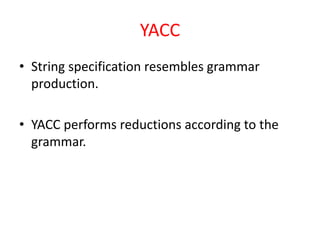System Programming Overview
- 1. System Programming Prof. D. P. Gandhmal WIT, Solapur
- 2. Chapter 1: Language Processor • Introduction • Language Processing Activities • Fundamentals of Language Processing • Fundamentals of Language Specification • Language Processing Development Tools
- 3. Introduction • Why Language Processor? – Difference between the manner in which software designer describes the ideas (How the s/w should be) and the manner in which these ideas are implemented(CPU).
- 5. • Consequences of Semantic Gap 1. Large development times 2. Large development efforts 3. Poor quality of software • Issues are tackled by Software Engineering through use of Programming Language.
- 7. Language Processors • A Language Processor is a software which bridges a specification or execution gap. • Program to input to a LP is referred as a Source Program and output as Target Program. • Languages in which they are written are called as source language and target languages respectively.
- 8. A Spectrum of Language Processor • A language translator bridges an execution gap to the machine language of a computer system. • A detranslator bridges the same execution gap as the language translator but in reverse direction. • A Preprocessor is a language processor which bridges an execution gap but is not a language translator. • A language migrator bridges the specification gap between two PL’s.
- 10. Interpreters • An interpreter is a language processor which bridges an execution gap without generating a machine language program. • Here execution gap vanishes totally. Application Domain PL Domain Execution Domain Interpreter Domain
- 11. Application Domain Problem Oriented Language Execution Domain PL Domain Specification Gap Execution Gap
- 12. Application Domain Procedure Oriented Language Execution Domain PL Domain Specification Gap Execution Gap
- 13. Language Processing Activities • Divided into those that bridge the specification gap and those that bridge the execution gap. 1. Program generation activities. 2. Program execution activities.
- 14. Program Generation • It is a software which accepts the specification of a program to be generated and generates a program in the target PL. Program generator Program specification Program in target PL Errors
- 16. Example • A screen handling Program • Specification is given as below Employee name : char : start(line=2,position=25) end(line=2,position=80) Married : char : start(line =10, position=25) end(line=10,position=27) default(‘Yes’)
- 17. Yes Employee Name Address Married Age Gender Figure: Screen displayed by a screen handling program
- 18. Program Execution • Two models of Program Execution – Program translation – Program interpretation
- 19. Program Translation • Program translation model bridges the execution gap by translating a program written in PL i.e Source Program into machine language i.e Target Program. Translator m/c language program Source Program Target Program Errors Data Figure: Program translation model
- 20. Program Interpretation • Interpreter reads the source program and stores it in its memory. • During interpretation it determines the meaning of the statement.
- 21. • Instruction Execution Cycle 1. Fetch the instruction 2. Decode the instruction and determine the operation to be performed. 3. Execute the instruction.
- 22. • Interpretation Cycle consists of— 1. Fetch the statement. 2. Analyze the statement and determine its meaning. 3. Execute the meaning of the statement.
- 23. Source program + Data Interpreter Memory PC Machine language program + Data CPU Memory PC Errors Figure (a) : Interpretation Figure (b) : Program Execution
- 24. • Characteristics of interpretation 1. Source program is retained in the source form itself i.e no target program. 2. A statement is analyzed during its interpretation.
- 25. Fundamentals of Language Processing • Lang Processing = Analysis of SP+ Synthesis of TP. • Analysis consists of three steps 1. Lexical rule identifies the valid lexical units 2. Syntax rules identifies the valid statements 3. Semantic rules associate meaning with valid statement.
- 26. Example:- percent_profit := (profit * 100) / cost_price; Lexical analysis identifies------- :=, * and / as operators 100 as constant Remaining strings as identifiers. Syntax analysis identifies the statement as the assignment statement. Semantic analysis determines the meaning of the statement as profit x 100 cost_price to percent_profit
- 27. • Synthesis Phase 1. Creation of DS 2. Generation of target code Refered as memory allocation and code generation, respectively. MOVER AREG, PROFIT MULT AREG, 100 DIV AREG, COST_PRICE MOVEM AREG, PERCENT_PROFIT ------------------- PERCENT_PROFIT DW 1 PROFIT DW 1 COST_PRICE DW 1
- 28. Analysis Phase and Synthesis phase is not feasible due to 1. Forward References 2. Memory Requirement
- 29. Forward Reference • It is a reference to the entity which precedes its definition in the program. percent_profit := (profit * 100) / cost_price; …….. …….. long profit;
- 30. Language Processor Pass • Pass I : performs analysis of SP and notes relevant information. • Pass II: performs synthesis of target program. Pass I analyses SP and generates IR which is given as input to Pass II to generate target code.
- 31. Intermediate Representation (IR) • An IR reflects the effect of some but not all, analysis and synthesis tasks performed during language processing. Front End Back End Intermediate Representation (IR) Source Program Target Program
- 32. • Properties 1. Ease of use. 2. Processing efficiency. 3. Memory efficiency.
- 33. Toy Compiler • Front End Performs lexical, syntax and semantic analysis of SP. Analysis involves 1. Determine validity of source stmt. 2. Determine the content of source stmt. 3. Construct a suitable representation.
- 34. Output of Front End 1. Tables of information 2. Intermediate code (IC) IC is a sequence of IC units, represents meaning of one action in SP
- 35. Example i: integer; a,b: real; a := b+i; Symbol Table. No. Symbol Type Length Address 1 i int 2 a real 3 b real 4 i* real 5 temp real
- 36. • Intermediate code 1. Convert (id, #1) to real, giving (id, #4) 2. Add (id, #4) to (id, #3) giving (id, #5) 3. Store (id, #5) in (Id, #2)
- 37. Lexical Analysis (Scanning) • Identifies lexical units in a source statement. • Classifies units into different classes e.g id’s, constants, reserved id’s etc and enters them into different tables • Token contains – Class code and number in class Code #no Id #10e.g.
- 38. • Example Statement a := b + i; a := b + i ; Id #2 Op #5 Id #3 Op #3 Id #1 Op #10
- 39. Syntax Analysis (Parsing) • Determines the statement class such as assignment statement, if stmt etc. e.g.:- a , b : real; and a = b + I ; real a b := a + b i
- 40. Semantic Analysis • Determines the meaning of the SP • Results in addition of info such as type, length etc. • Determines the meaning of the subtree in IC and adds info to the IC tree.
- 41. Stmt a := b +i; proceeds as 1. Type is added to the IC tree 2. Rules of assignment indicate expression on RHS should be evaluated first. 3. Rules of addition indicate i should be converted before addition i. Convert i to real giving i*; ii. Add i* to b giving temp. iii. Store temp in a.
- 42. := a, real + b, real i, int := a, real + b, real i*, int := a, real temp, real (a) (b) (c)
- 43. Scanning Parsing Semantic analysis Symbol table Constant table Other table Source Program Lexical errors Syntax errors Semantic errors IC IR Figure: Front end of a Toy Compiler tokens Parse tree
- 44. Back End 1. Memory Allocation Calculated form its type, length and dimentionality. No. Symbol Type Length Address 1 i int 2000 2 a real 2001 3 b real 2002
- 45. • Code generation 1. Determine places where results should be kept in registers/memory location. 2. Determine which instruction should be used for type conversion operations. 3. Determine which addressing modes should be used for accessing variables.
- 46. CONV_R AREG, I ADD_R AREG, B MOVEM AREG, A Figure: Target Code
- 47. Memory allocation Code generation Symbol table Constants table Other tables Target program IR IC Figure: Back End of the toy compiler
- 48. Fundamentals of Language Specification • Programming Language grammars. alphabets Words / Strings Sentences/ Statements Language
- 49. Terminal symbols, alphabet and strings • The alphabet of L is represented by a greek symbol Σ. • Such as Σ = {a , b , ….z, 0, 1,…. 9} • A string is a finite sequence of symbols. α= axy
- 50. Productions • Also called as rewriting rule A nonterminal symbol ::= String of T’s and NT’s e.g.: <Noun Phrase> ::= <Article> <Noun> <Article> ::= a| an | the <Noun> ::= boy | apple
- 51. Grammar • A grammar G of a language LG is a quadruple (Σ, SNT, S, P) where – Σ is the alphabet – SNT is the set of NT’s – S is the distinguished symbol – P is the set of productions
- 52. Derivation • Let production P1 of grammar G be of the form P1 : A ::= α And let β be such that β = γAθ β = γαθ
- 53. Example <Sentence> :: = <Noun Phrase> <Verb Phrase> <Noun Phrase> ::= <Article> <Noun> <Verb Phrase> ::= <Verb> <Noun Phrase> <Article> ::= a| an| the <Noun> ::= boy | apple <Verb> ::= ate
- 54. <Sentence> <Noun Phrase> <Verb Phrase> <Article> <Noun> <Verb Phrase> <Article> <Noun> <Verb> <Noun Phrase> the <Noun> <Verb> <Article> <Noun> the boy <Verb> <Article> <Noun> the boy ate <Article> <Noun> the boy ate an <Noun> the boy ate an apple
- 55. Binding and Binding Times • Program entity pei in program P has a some attributes. pei kind variable procedure Reserved id etc type dimen Mem addr etc size
- 56. Definition • A binding is an association of an attribute of a program entity with a value. • Binding time is the time at which binding is performed. int a;
- 57. Different Binding Times 1. Language definition time of L 2. Language implementation time of L 3. Compilation time of P 4. Execution init time of proc 5. Execution time of proc
- 58. program bindings(input , output); var i : integer; a,b : real; procedure proc (x: real; j: integer); var info : array[1…10,1…5] of integer; p : integer; begin new (p); end; begin proc(a,i); end
- 59. 1. Binding of keywords with its meaning. e.g.: program, procedure, begin and end. 2. Size of type int is bind to n bytes. 3. Binding of var to its type. 4. Memory addresses are allocated to the variables. 5. Values are binded to memory address.
- 60. Types of Binding • Static Binding: – Binding is performed before the execution of a program begins. • Dynamic Binding: – Binding is performed after the execution of a program has begun.
- 61. Language Processor Development Tools (LPDT) LPDT requires two inputs: 1. Specification of a grammar of language L 2. Specification of semantic actions Two LPDT’s which are widely used 1. LEX (Lexical analyzer) 2. YACC (Parser Generator)
- 62. It contains translation rules of form <string specification> { <semantic action>} Front end generator Grammar of L Semantic action Scanning Parsing Semantic analysis Source Program IR Front end
- 63. Scanner Parser LEX YACC Source Program in L IR Lexical Specification Syntax Specification
- 64. LEX • LEX consists of two components – Specification of strings such as id’s, constants etc. – Specification of semantic action
- 65. %{ //Symbols definition; 1st section %} %% //translation rules; 2nd section Specification Action %% //Routines; 3rd section
- 66. % { letter [A-Za-z] digit [0-9] }% %% begin {return(BEGIN);} end {return(END);} {letter} ( {letter}|{digit})* {yylval = enter_id(); return(ID);} {digit}+ {yylval=enter_num(); return(NUM);} %% enter_id() { /*enters id in symbol table*/ } enter_num() {/* enters number in constabts table */}
- 67. YACC • String specification resembles grammar production. • YACC performs reductions according to the grammar.
- 68. Example %% E : E+T {$$ = gencode(‘+’, $1, $3);} | T {$$ = $1;} T : T*V {$$ = gencode(‘*’, $1, $3);} | V {$$ = $1;} V : id {$$ = gendesc($1);} %% gencode (operator, operand_1, operand_2){ } gendesc(symbol) { }
- 69. Thank You!!!














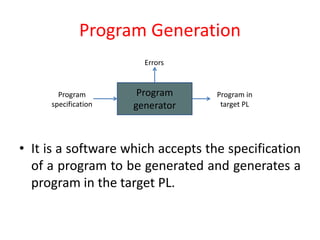


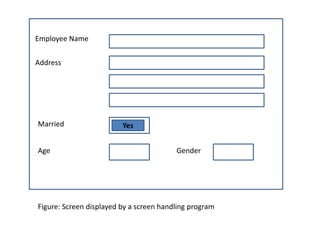
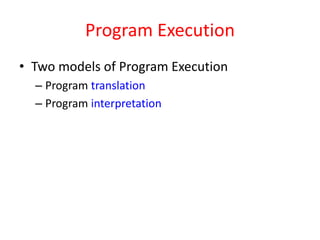



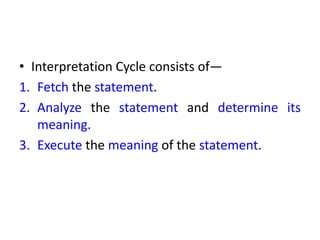
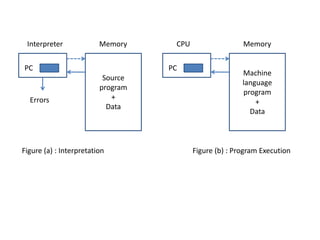

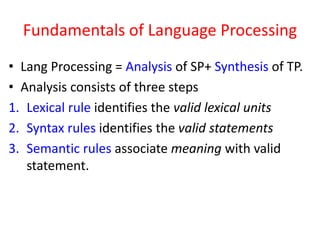

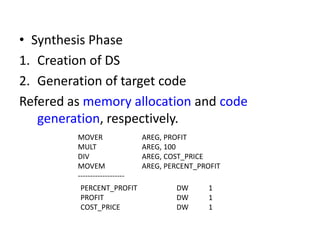
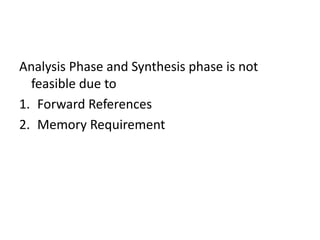



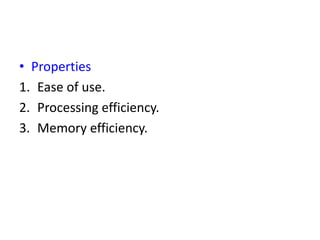

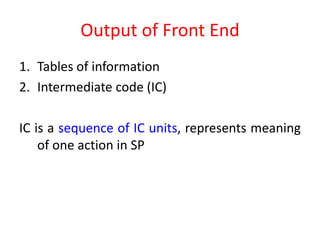



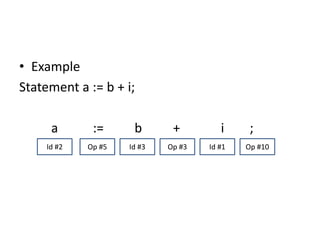
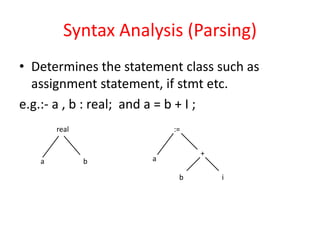
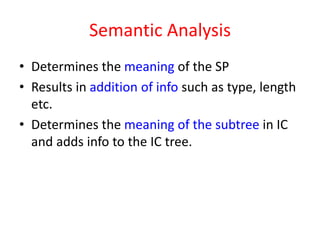
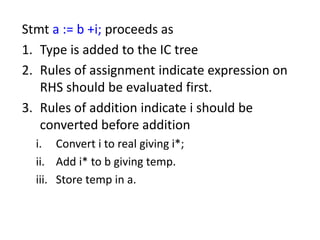


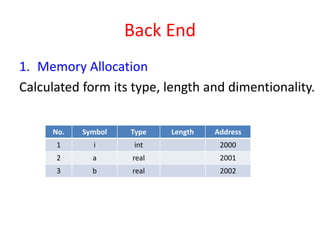


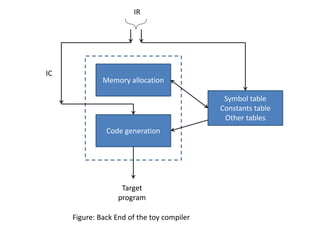

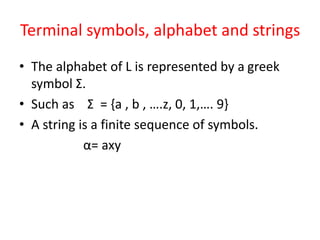

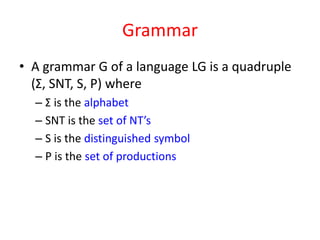





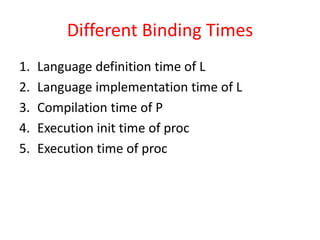
![program bindings(input , output);
var
i : integer;
a,b : real;
procedure proc (x: real; j: integer);
var
info : array[1…10,1…5] of integer;
p : integer;
begin
new (p);
end;
begin
proc(a,i);
end](https://image.slidesharecdn.com/systemprogrammingchapter1-140327021243-phpapp01/85/System-Programming-Overview-58-320.jpg)







![% {
letter [A-Za-z]
digit [0-9]
}%
%%
begin {return(BEGIN);}
end {return(END);}
{letter} ( {letter}|{digit})* {yylval = enter_id();
return(ID);}
{digit}+ {yylval=enter_num();
return(NUM);}
%%
enter_id()
{ /*enters id in symbol table*/ }
enter_num()
{/* enters number in constabts table */}](https://image.slidesharecdn.com/systemprogrammingchapter1-140327021243-phpapp01/85/System-Programming-Overview-66-320.jpg)
